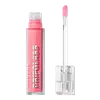NYX Cosmetics Duck Plump High Pigment Plumping Lip Gloss Versus Morphe Dripglass Glazed High Shine Lip Gloss
What's inside
What's inside
 Key Ingredients
Key Ingredients

 Benefits
Benefits

 Concerns
Concerns

 Ingredients Side-by-side
Ingredients Side-by-side

C18-36 Acid Triglyceride
EmollientBis-Diglyceryl Polyacyladipate-2
EmollientPentaerythrityl Tetraisostearate
EmollientPolybutene
Tridecyl Trimellitate
EmollientDiisostearyl Malate
EmollientSilica Dimethyl Silylate
EmollientPentylene Glycol
Skin ConditioningPhenoxyethanol
PreservativeEthylhexyl Palmitate
EmollientPentaerythrityl Tetra-Di-T-Butyl Hydroxyhydrocinnamate
AntioxidantTribehenin
EmollientCapsicum Frutescens Fruit Extract
Skin ConditioningEthylhexylglycerin
Skin ConditioningSorbic Acid
PreservativeVanillyl Butyl Ether
MaskingZingiber Officinale Root Extract
MaskingTocopheryl Acetate
AntioxidantSodium Saccharin
MaskingSorbitan Isostearate
EmulsifyingLactic Acid
BufferingAluminum Hydroxide
EmollientCitral
PerfumingSilica
AbrasiveLimonene
PerfumingPalmitoyl Tripeptide-1
Skin ConditioningLinalool
PerfumingTocopherol
AntioxidantC18-36 Acid Triglyceride, Bis-Diglyceryl Polyacyladipate-2, Pentaerythrityl Tetraisostearate, Polybutene, Tridecyl Trimellitate, Diisostearyl Malate, Silica Dimethyl Silylate, Pentylene Glycol, Phenoxyethanol, Ethylhexyl Palmitate, Pentaerythrityl Tetra-Di-T-Butyl Hydroxyhydrocinnamate, Tribehenin, Capsicum Frutescens Fruit Extract, Ethylhexylglycerin, Sorbic Acid, Vanillyl Butyl Ether, Zingiber Officinale Root Extract, Tocopheryl Acetate, Sodium Saccharin, Sorbitan Isostearate, Lactic Acid, Aluminum Hydroxide, Citral, Silica, Limonene, Palmitoyl Tripeptide-1, Linalool, Tocopherol
Polyisobutene
Octyldodecanol
EmollientEthylhexyl Palmitate
EmollientCaprylic/Capric Triglyceride
MaskingHydrogenated Styrene/Isoprene Copolymer
Bis-Diglyceryl Polyacyladipate-2
EmollientSynthetic Wax
AbrasiveStearalkonium Hectorite
Gel FormingMica
Cosmetic ColorantPhenoxyethanol
PreservativePropylene Carbonate
SolventParfum
MaskingSqualane
EmollientTocopheryl Acetate
AntioxidantAluminum Hydroxide
EmollientPentaerythrityl Tetra-Di-T-Butyl Hydroxyhydrocinnamate
AntioxidantTin Oxide
AbrasiveBenzyl Alcohol
PerfumingHydroxycitronellal
PerfumingBenzyl Salicylate
PerfumingHexyl Cinnamal
PerfumingTitanium Dioxide
Cosmetic ColorantCI 15850
Cosmetic ColorantCI 19140
Cosmetic ColorantPolyisobutene, Octyldodecanol, Ethylhexyl Palmitate, Caprylic/Capric Triglyceride, Hydrogenated Styrene/Isoprene Copolymer, Bis-Diglyceryl Polyacyladipate-2, Synthetic Wax, Stearalkonium Hectorite, Mica, Phenoxyethanol, Propylene Carbonate, Parfum, Squalane, Tocopheryl Acetate, Aluminum Hydroxide, Pentaerythrityl Tetra-Di-T-Butyl Hydroxyhydrocinnamate, Tin Oxide, Benzyl Alcohol, Hydroxycitronellal, Benzyl Salicylate, Hexyl Cinnamal, Titanium Dioxide, CI 15850, CI 19140
Ingredients Explained
These ingredients are found in both products.
Ingredients higher up in an ingredient list are typically present in a larger amount.
Aluminum Hydroxide is a form of aluminum. It can be naturally found in nature as the mineral gibbsite. In cosmetics, Aluminum Hydroxide is used as a colorant, pH adjuster, and absorbent.
As a colorant, Aluminum Hydroxide may add opacity, or reduce the transparency. Aluminum hydroxide is contains both basic and acidic properties.
According to manufacturers, this ingredient is an emollient and humectant. This means it helps hydrate the skin.
In medicine, this ingredient is used to help relieve heartburn and help heal ulcers.
There is currently no credible scientific evidence linking aluminum hydroxide in cosmetics to increased cancer risk.
Major health organizations allow the use of aluminum hydroxide in personal care products and have not flagged it as a carcinogenic risk at typical usage levels.
Learn more about Aluminum HydroxideThis ingredient is lipid-based synthetic skin-conditioning agent derived from adipic acid and a mixture of fatty acids. It is often called a lanolin substitute.
As an emollient, it helps soften and hydrate the skin. Emollients create a barrier on the skin to trap moisture in.
Due to its fatty acid base, it may not be Malassezia folliculitis safe.
Learn more about Bis-Diglyceryl Polyacyladipate-2Ethylhexyl Palmitate, also known as octyl palmitate, is created from 2-ethylhexyl alcohol and palmitic acid. It is a fatty acid ester.
The fatty acid content of Ethylhexyl Palmitate makes it an emollient. Emollients help soften and hydrate your skin by trapping moisture within.
Ethylhexyl Palmitate is also used to help improve the texture of cosmetics. It helps other ingredient dissolve in products and help disperse ingredients more evenly.
You'll likely find this ingredient in sunscreen, as it is often used to mix UV-blocking ingredients such as avobenzone and ethylhexyl triazone.
It can also help stabilize the fragrances in a product as a fragrance fixative.
Ethylhexyl Palmitate can be used to substitute mineral oil.
Due to its high fatty acid content, it may not be fungal-acne safe.
Learn more about Ethylhexyl PalmitatePentaerythrityl Tetra-Di-T-Butyl Hydroxyhydrocinnamate (long name, huh?) is a synthetic antioxidant.
It is used to help stabilize other antioxidants or prevent the color from changing in a product.
As an antioxidant, it helps fight free-radical molecules. Free-radical molecules are capable of damaging our cells and other genetic material. Thus, antioxidants may reduce the signs of aging.
This ingredient is oil-soluble.
Learn more about Pentaerythrityl Tetra-Di-T-Butyl HydroxyhydrocinnamatePhenoxyethanol is a preservative that has germicide, antimicrobial, and aromatic properties. Studies show that phenoxyethanol can prevent microbial growth. By itself, it has a scent that is similar to that of a rose.
It's often used in formulations along with Caprylyl Glycol to preserve the shelf life of products.
Tocopheryl Acetate is AKA Vitamin E. It is an antioxidant and protects your skin from free radicals. Free radicals damage the skin by breaking down collagen.
One study found using Tocopheryl Acetate with Vitamin C decreased the number of sunburned cells.
Tocopheryl Acetate is commonly found in both skincare and dietary supplements.
Learn more about Tocopheryl Acetate